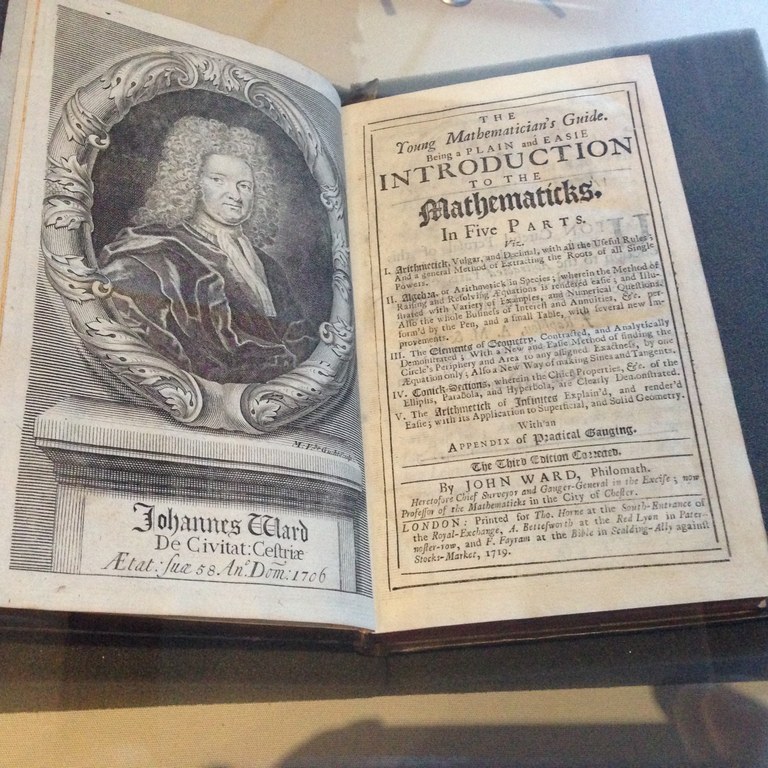Dublin's Most Worthy Library (Jan 2017)
Dublin's Most Worthy Library
Tucked away in Dr Steevens' Hospital, on the south side of the Liffey just two and a half kilometres west of O'Connell Bridge, is a remarkable room known as the Edward Worth Library. It resulted from a bequest made by physician Edward Worth (1676-1733) upon his demise.
The fine Thomas Burgh designed building housing it, currently the home of the Health Service Executive, was itself "willed into existence" upon the death of Richard Steevens (1653-1710). It's half way between Heuston Station (built in 1846) and St Patrick's Hospital, Jonathan Swift's mid 1700s gift to the nation. The Worth Library is located on the first floor of Dr Steevens' Hospital, facing east, and now overlooks a Guinness lorry-loading yard across Steevens' Lane. A portrait of Worth keeps a watchful eye on visitors from over the fireplace.
About 100 of the books in question are mathematical. The bulk of the roughly 4,400 tomes in Worth's collection, all published in the 250 years leading up to his death, are on science, medicine and the classics. Mathematician Maurice OReilly, long of St Patrick's, Drumcondra—now folded into an expanded DCU—recently marshalled colleague Fionnán Howard along with twenty of his undergraduate students to curate a free online tour of these volumes. An alphabetical list (by author) of 98 relevant items is now available online.
As the main library webpage observes,
"Though visiting scholars over the centuries and decades have witnessed a succession of historic styles in movable furniture (tables, desks, chairs etc.), the original book-shelves, cases, glass-panes and other fittings remain as they were in the 1730s. Indeed, the Edward Worth Library was probably the first in Ireland to protect books behind glass-fronted doors."
|
|

"The title page ... gives us a good indication not only of its contents but also of how the book became a mathematical bestseller in Georgian England and Ireland."
The earliest of the mathematical books in the library is a Paris edition of Cuthbert Tunstall's De arte supputandi libri quatuor (1538). Its 1522 original printing is said to have been the first work on arithmetic published in England. Worth inherited his copy from his grandfather (Bishop of Killaloe) and his father (Dean of St Patrick's Cathedral); it was one of many printings by renowned Robert Estienne that he was proud to have in his collection.
Exploring the main online mathematics exhibtion provides options (listed on the left of that webpage) under headings such as, Arithmetic, Algebra, Geometry, Conic Sections, Infinities, Probability, and so on. The Conic Sections spin-off page is particularly interesting, as it discusses one of the earliest known Irish books on mathematics: Robert Steell's Conic Sections (1723). Published by George Grierson, "at the Two Bibles in Essex-Street," it was dedicated to the (fellows, scholars and) Provost of the "College of Dublin" (presumably Trinity, in which case Richard Baldwin was that office holder at the time). The full text of a later edition is online here.
Dr Steevens' Hospital holds many other pleasant surprises, some of which can be viewed when entering or leaving the Worth library. One is a rare portrait of Bryan Robinson (1680-1754), another Dublin physician with mathematical leanings. Curiously, it appears that Worth did not own a copy of Robinson's New Elements of Conick Sections (1704), a translation of Philippe de La Hire's Sectiones conicæ (1685).
Visitors to the Edward Worth Library should look out for the set of framed illustrations nearby, brought out by the University of Leiden in 1610. One features fencers deployed in an array with projective geometry overtones.
The physical part of the new mathematical exhibition is viewable, by prior arrangement, until the end of February 2017.
See here for a blog about Marsh's Library.
Special thanks to librarian Elizabethanne Boran for her tour and for sharing her expertise and enthusiasm so willingly. All images courtesy of Colm Mulcahy except as noted.